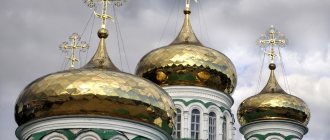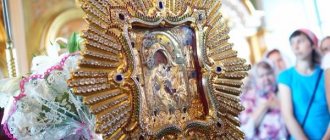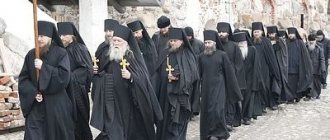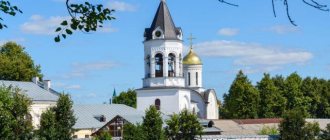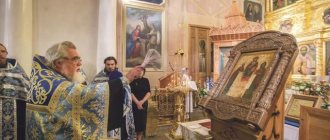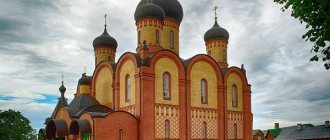| Zhirovitsky Assumption Monastery, September 25, 2010. Photo by Alexey Drupov from the site sobory.ru |
Monastery in honor of the Dormition of the Blessed Virgin Mary in the village of Zhirovichi
, stauropegy of the Belarusian Orthodox Church within the boundaries of the Novogrudok diocese
- Address: Belarus, 231822, Grodno region, Slonim district, Zhirovichi village, st. Sobornaya, 57
- Tel.: (+375 1562) 9-63-91, 9-68-63
- On the map: Yandex.Map, Google map
The main spiritual center of Belarusian Orthodoxy, the location of the greatest shrine - the icon of the Zhirovitsk Mother of God.
Story
The monastery owes its existence to the miraculous appearance of the icon of the Most Holy Theotokos in 1470. After the construction of a wooden church on the site where the icon was found, a village arose here and a parish was formed.
Initially, the miraculous icon was kept in a wooden church built on the site of its appearance. Around 1520 there was a severe fire that destroyed both the wooden temple and almost all the buildings. Only the church school survived. The miraculous icon also disappeared in the fire, after which it was miraculously found a second time.
Subsequently, a monastery was formed in Zhirovichi; it was first mentioned in documents in 1587.
Uniate Monastery
During the struggle for the Orthodox faith, at the request of the Vilna Tribunal in 1609, a union was adopted in Zhirovichi, and from 1613 the monastery passed into the hands of the Basilian Order. Since the miraculous icon remained in the monastery, revered by the people, it continued to remain the center of the spiritual life of the region.
On the site of the burnt church in 1613, the stone Cathedral of the Assumption of the Virgin Mary was founded, in which the miraculous icon is kept to this day.
In 1655, during the war between the Muscovite kingdom and the Polish-Lithuanian Commonwealth, the Zhirovitsky monastery was burned by the troops of the prince. A. N. Trubetskoy, who wrote to Tsar Alexei Mikhailovich that “in the city of Slonim, the Lithuanian people who found, flogged the city of Slonim and the settlement and the Zhuravitskaya Uniyatskaya monastery, a stone city and near the Zhuravitsky monastery and churches were burned and people were beaten ... and fought September to 1st"
[1]. Probably, the monastery was soon restored, otherwise convening in it in 1658, 1659, 1661. general chapters of the Basilian Order would have been impossible. The 1661 congregation expressed special gratitude to Rev. Samson Boreysha for managing to preserve the monastery.
At the beginning of the 18th century. In connection with the Northern War, the Polish-Lithuanian Commonwealth was divided into warring factions of supporters of Sweden and Russia. During the fighting, the Basilians exported the valuable property of the Zhirovitsky monastery deep into Poland. The monastery and its estates were devastated by Swedish troops, who took a huge indemnity.
In 1710, an outbreak of pestilence and mass death of the population were noted in Belarus and Lithuania. At the same time, several hundred Uniate monks died in Zhirovichi; according to legend, only one hieromonk remained alive. Those who died during the epidemic were buried not only in the cemetery, but also on the territory of the monastery and in the monastery gardens.
After 1710, the monastery was revived, a new fraternal building, a fence and other premises were built.
In the XVII-XVIII centuries. The Zhirovitsky Monastery was a significant book center. In 1636, the Basilian congregation decided to purchase books annually for his library. Church regent Gilarion Skrosinsky donated 3,500 gold pieces for this purpose. In the beginning. XIX century The monastery received books from the Brest Jesuits and Basilians. Books were copied in the monastery, and there was a small printing house. The monastery library contained a large collection of Church Slavonic, Old Belarusian, Polish, Latin handwritten and printed books. In the 19th century part of the library and archival collection of Zh. m. was taken to Russia by bishop. Pavel (Dobrokhotov), the other part was transferred to the Vilna Public Library. These funds have been preserved in the collections of the Russian BAN (St. Petersburg) and the Lithuanian BAN (Vilnius).
In 1795, as a result of the 3rd partition of the Polish-Lithuanian Commonwealth, Zhirovichi became part of the Russian Empire. In 1810, in connection with the reorganization of Russian Greek Catholic dioceses, the center of the Brest Uniate Diocese moved to Zhirovichi, and the monastery Assumption Cathedral became a cathedral.
In the 1820s. Preparations began in the monastery for the reunification of Western Russian Uniates with the Orthodox Church. By decree of the imp. Nicholas I on April 22, 1828, the See of Lithuanian Uniate Bishops was located in the Zhirovitsky Monastery. On October 7 of the same year, a Greek Catholic theological seminary was opened in Mon-Re (instead of a primary school), the rector of which was Anthony (Zubko), one of the participants in the process of liquidation of the Union of Brest. In 1839, the seminary was transformed into the Orthodox Lithuanian Theological Seminary with a lower theological school.
Reunification with the Orthodox Church
In the 1830s. The “cleansing” of the Uniate rite from Catholic layers began; in the churches of the Zhirovitsky monastery, as in the entire Lithuanian diocese, side altars, statues, organs were abolished, and iconostases were arranged according to the rite of the Orthodox Church. On February 12, 1839, the Council of the Uniate clergy in Polotsk adopted an act of accession to Orthodoxy. Of the figures who prepared the reunification of the Belarusian-Litovs. Uniates, Metropolitan lived and worked in Zhirovichi. Joseph (Semashko), Archbishops Anthony (Zubko), Mikhail (Golubovich), Bishops Pavel (Dobrokhotov), Ignatius (Zhelezovsky), Protopres. Anthony Tupalsky, Archpriest. Plakid Yankovsky and others. Archbishop is buried in the monastery. Minsky and Bobruisk Mikhail (Golubovich) in the crypt of the Church of Yavlensk and others. Plakid Yankovsky in the cemetery's St. George's Church.
In 1839-1844. with the establishment of the Lithuanian and Vilna diocese, the chair of the Lithuanian archbishop was located in the Zhirovitsky monastery.
Since 1845, in connection with the transfer of the diocesan center and theological seminary to Vilna, a 2nd class monastery and a theological school were left in Zhirovichi.
Archimandrite, who headed the monastery for 30 years (since 1852). Nicholas (Redutto) carried out major repairs and reconstruction of the monastery complex. After his appeal in December 1865 to benefactors of the Russian Empire, the Zhirovitsky Monastery received significant donations. By 1867, the monastery was rebuilt, the buildings were consecrated according to the Russian Orthodox Church. traditions. In the second half of the 19th century. the number of pilgrims to the miraculous Zhirovitsky image and to the healing spring under the altar of the Assumption Cathedral, at the site of the appearance of the icon, increased.
Due to the approach of the Russian-German front in 1915, the Zhirovitsky monastery and its shrines were evacuated deep into Russia, and the Zhirovitsky Icon of the Mother of God was transported to Moscow. The only monk remaining in the monastery, monk Auxentius, was arrested by the invaders and sent to prison. During the period of German occupation 1915-1918. the monastery buildings were looted and desecrated. Since 1918, the restoration of the monastery began, which was facilitated by the nuns of the Grodno and Krasnostok wives. monasteries, upon returning from evacuation, they temporarily stopped in Zhirovichi.
Polish period
After the conclusion of the Soviet-Polish. of the Riga Peace Treaty from March 1921, the Zhirovitsky Monastery was part of Poland. Some monastery buildings and part of the land requisitioned by the Polish authorities were transferred to the agricultural forestry school.
In the 1920s Polish authorities attempted to transfer the monastery to Catholics. Mass protests of the Orthodox population of the West. Belarus, which organized crowded religious processions to the Zhirovitsky Monastery, thwarted plans for its closure. Only the Church of the Exaltation of the Cross was captured and converted into a church by the Roman Catholics.
German occupation
With the beginning of the Second World War in 1939, the territory of the West. Belarus and Western Ukraine became part of the USSR, but from the first days of the Great Patriotic War the Zhirovitsky Monastery found itself in occupied territory. German military units and the commandant's office occupied the territory of the Zhirovitsky monastery, shooting several monks, but thanks to the intervention of the archbishop. Panteleimon (Rozhnovsky) and Bishop. Benedict (Bobkovsky) of Brest were soon taken out of the monastery. The Yavlenskaya Church, used by the Nazis as an ammunition depot, was also cleared and returned to the monastery.
Soviet period
In 1945, part of the monastery buildings was occupied by an agricultural technical school. In the same year, theological and pastoral courses were opened at the Zhirovitsky Monastery, which in 1947 were transformed into the Minsk Theological Seminary.
In 1963, the seminary located in the monastery was closed, a new stage of oppression of the brethren began, pilgrims’ access to the source under the altar of the Assumption Cathedral was stopped, and part of the monastery buildings was occupied as a hospital.
In 1989, the seminary was revived.
Modern stage
Since 1992, the Zhirovitsky Monastery has been a stauropegy of the Belarusian Orthodox Church.
The monastery includes 5 active churches, 4 residential buildings, outbuildings, as well as a monastery pond, a garden, a vegetable garden and an apiary. There are 32 monastic brethren working in the monastery (as of December 31, 2006), including one bishop, three archimandrites, four abbots, five hieromonks, three hierodeacons, four monks, three monks and nine novices.
Monastery location
The complex is located 11 km from Slonim. The main street of the settlement passes through this place. Address of the spiritual center: st. Sobornaya, 57.
Interesting places include three holy springs. Two of them are open to visitors.
The old one (about 200 years old) is located at the end of the Soviet Border Guards Street. In 2008, a chapel was erected on its territory in the name of the Holy Equal-to-the-Apostles Princess Olga.
The new holy spring is located near the M-11 highway. There are two bathhouses here: women's and men's. A chapel was also built on its territory.
Only monks go down to the third source. A spring flows out from under the altar (the legendary pear tree with an icon used to grow here). The source is designed in the form of a grotto with a ceiling, painted walls, and a tree with a holy image.
How to get there
You can get to Zhirovichi by private car. They are driving along the M1 highway Minsk-Brest. They turn towards Slonim and follow the signs to find themselves in Zhirovichi.
By bus - from Grodno, making a transfer in Slonim. The Minsk-Grodno train goes to Grodno, the ticket costs 13 rubles. Travel time to Slonim is about two hours. It's better to leave early in the morning. The last bus leaves at 18.20.
For an overnight stay, you can book a place in the monastery hotel. There are many bus routes from Slonim to Zhirovichi.
Architecture
The monastery complex has an irregular layout, a picturesque volumetric-spatial composition and an expressive silhouette. The core of the ensemble is the Assumption Cathedral, connected by covered passages to the seminary building and a residential building, on the ground floor of which there is an arched passage to the territory of the monastery. The seminary building forms the front courtyard in front of the apse of the cathedral. In the southeast of the cathedral is the Church of Yavlenskaya. In the eastern part of the monastery, on the highest place, the Church of the Exaltation of the Cross was built - the vertical dominant of the ensemble.
Holy Cross Church
At the beginning of the 18th century, one of the parishioners of the Zhirovichi monastery - a certain Eleonora Golovishchina - brought a gift of 8 thousand gold pieces for the construction of the Church of the Passion of Christ so that later funeral services would be held there. Construction was completed in 1769.
This is a calvarium temple, which is dedicated to the rite of pilgrimage to Jerusalem. The staircase in the temple occupies half of the room. It is a complete copy of the one by which they led Jesus Christ to the unrighteous trial.
Abbots, governors
- Nicholas (Redutto) (1852 - 1882)
- Stefan (Kistrussky) (October 25, 1897 - November 12, 1901)
- Afanasy (Sambikin) (February 15, 1902 - April 22, 1904)
- Misail (Krylov) (April 29, 1904 - December 24, 1905)
- Feofilakt (Klementyev) (August 23, 1907 - April 24, 1911)
- Tikhon (Sharapov) (1922 - 1924)
- Dimitry (Magan) (1935 - 1941)
- Venedikt (Bobkovsky) (1941 - 1942), archimandrite.
- Seraphim (Kudryavtsev) (1942 - 1943), archimandrite.
- Bogolep (Antsukh) (1943 - 1947)
- Mitrofan (Gutovsky) (1947 - 1953)
- Leonty (Bondar) (July 1953 - 1956)
- Anthony (Melnikov) (1956 - 1963)
- Mikhei (Kharkharov) (1963 - 1969)
- Konstantin (Khomich) (1970 - 1987)
- Stefan (Korzun) (1987 - 1990)
- Gury (Apalko) (from March 6, 1990)
Patronal holidays
They are celebrated in the monastery with special solemnity.
Main holidays:
- Appearance of the Zhirovichi Icon - May 20;
- Intercession of the Blessed Virgin Mary - October 14;
- Nativity of St. John the Baptist - July 7;
- Dormition of the Mother of God - August 28;
- Exaltation of the Honest and Life-Giving Cross of the Lord - September 27;
- Memorial Day of St. Nicholas the Wonderworker - December 19 and May 22.
Also solemnly celebrated on September 6 is the memory of the holy Venerable Martyr Seraphim of Zhirovitsky, the day before there is a religious procession with his icon from the Slonim church dedicated to him.
Used materials
- “Holy Dormition Zhirovichi Stauropegial Monastery”, page of the official portal of the Belarusian Orthodox Church:
- Pages of history
, website page of Minsk Theological Schools: - Page of the official website of the Pilgrimage Department of the Belarusian Orthodox Church:
- Zhirovitsky Assumption Monastery
, Fragment of an article from volume 19 of the “Orthodox Encyclopedia”. Moscow, 2008 (partially used) - Website page “People's catalog of Orthodox architecture”:
- Vladimir Sorokin, prot. “Confessor”, Church-educational activities of Metropolitan Gregory (Chukov)
/ St. Petersburg: Publishing house of the Prince Vladimir Cathedral, 2005, p. 623, 687, 703.
[1] Encyclopedic histories of Belarus. Minsk, 1994. T. 2. P. 197
Divine services
The Zhirovichi Monastery is not a museum attraction. This is a famous center of Orthodoxy. Its beauty is expressed not only in stone construction, but above all in the souls of people, which is why it is always crowded here.
Divine service in the Holy Dormition Church of the Zhirovichi Monastery
The early liturgy in the cathedral begins at 6:00, the late liturgy at 9:00. At this time, the interior of the temple is illuminated only by candles. On weekdays, many parishioners gather at the cathedral for evening services. There are many pilgrims among those praying. Every evening after the service, the monks of the monastery with the Mother of God icon make a religious procession throughout the entire territory of the monastery.
Holy Assumption Cathedral
It was built in 1613 and is considered the main church of the monastery in Zhirovichi. Funds for its construction were allocated by Ivan Meleshko, who at that time was the owner of Zhirovichi. The interior decoration was carried out with the money of Lev Sapieha, he held the position of Chancellor of the Principality of Lithuania. The height of the cathedral is 40 and the length is 55 meters. Previously, under the building there was a fraternal burial vault and burial places of noble persons. In the 18th century, the tomb was walled up. In the center of the iconostasis there is an icon of the “Savior Almighty” in a silver frame. The walls have preserved paintings from all times. On weekends, this cathedral holds: on Saturday from 06:00 am - early Divine Liturgy, from 18:00 evening Divine service. And on Sundays and on holidays two liturgies are served - 06:30 and 09:30.
